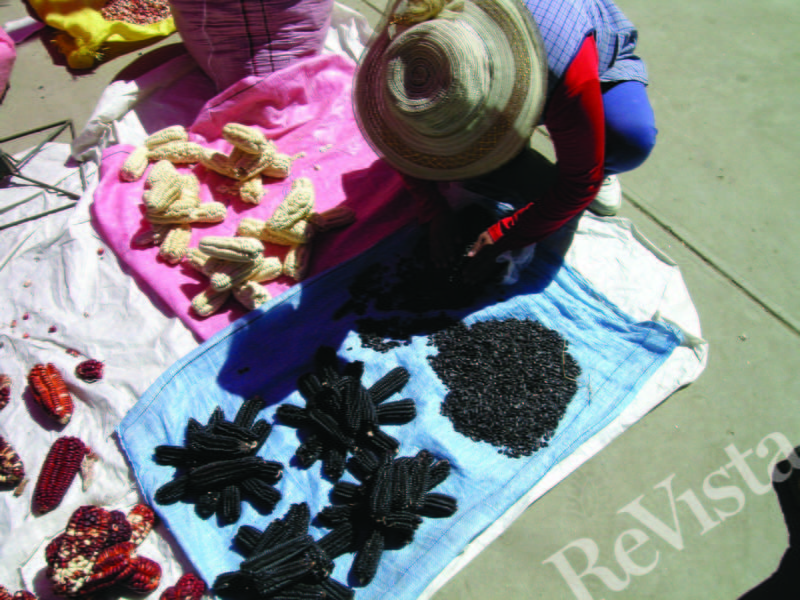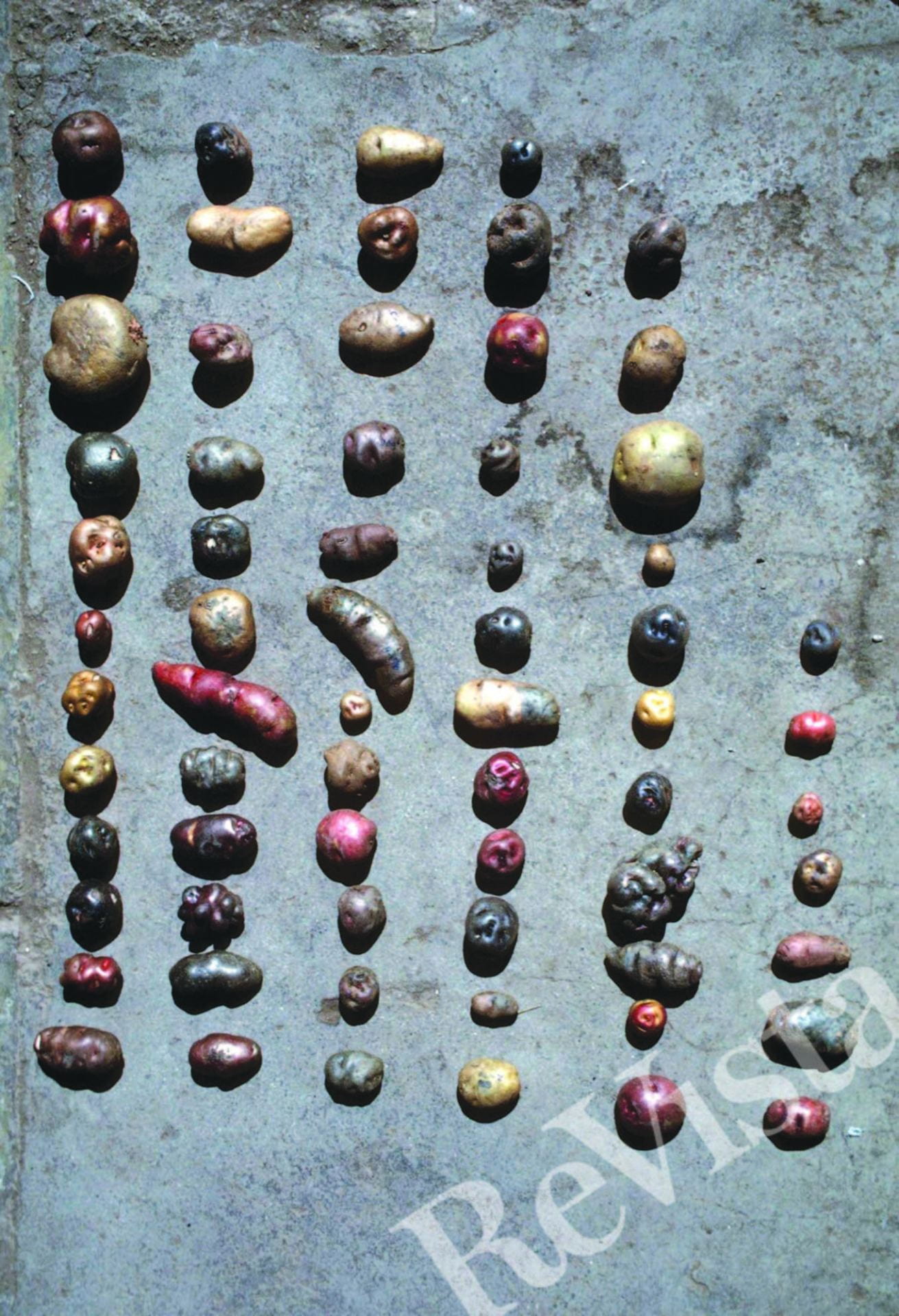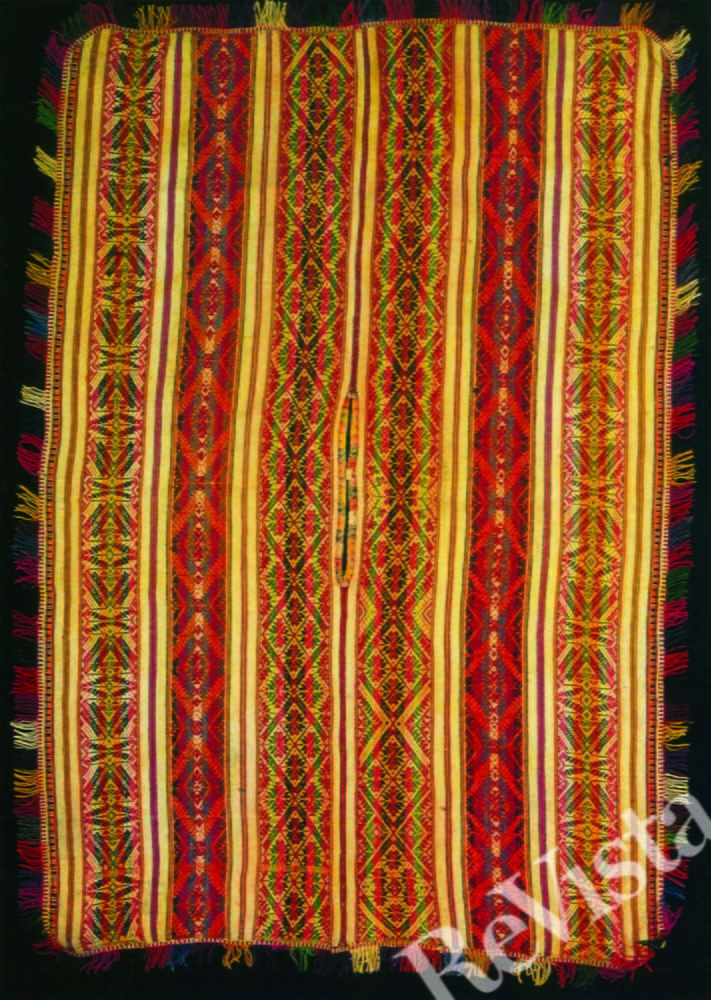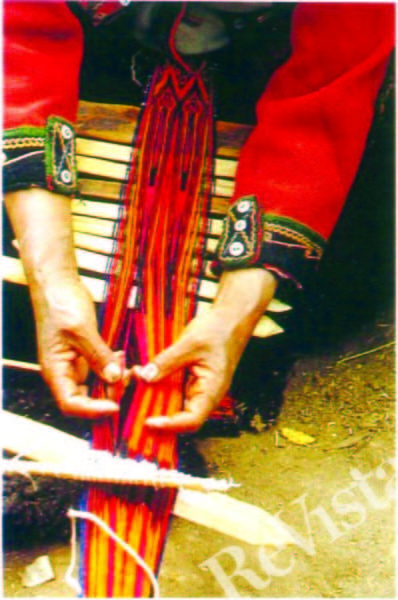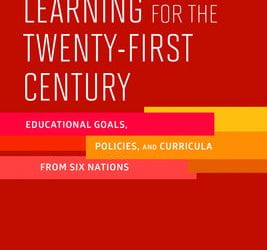Agrobiodiversity as Jazz Improvisation Foodscape
Change and Continuity
Yellow and purple maize, a multitude of assorted beans, sculptural manioc and a plethora of potatoes are a vivid illustration of the biodiversity of foods in the open-air markets of Latin America. Even in the supermarket era of the early 21st century, I love to marvel at what we call agrobiodiversity, shown in the visual variety of the market’s staple grains and tubers, as well as the lush fruits and vegetables and assorted other products. I walk through the market, smelling the mix of flowers and spices and tasting samples of potatoes and sauces—a highly sensory experience.
Such agrobiodiversity is complex. Imagine the reality of more than 4,000 local varieties of Andean potatoes, with about eighty varieties harvested from a mere handful of fields. Yet in my abundant talking with vendors, farmers, cooks, consumers and chefs, this agrobiodiversity begins to make sense.
That’s what I do as a research scientist and professor, interweaving the environmental, ecological and social sciences in the field, lab and classroom. My projects with growers and consumers range from ones including Andean potatoes and the important “minor” edible tubers and grains to the complexes of maize, beans and manioc. My investigations encompass Peru, Bolivia, Ecuador and other parts of South America as well as Mexico, Central America and the Caribbean—and beyond. Now in my third decade of these activities I relish every chance to explore further the worlds of foods and their environments.
Widely recognized as a global center and hotspot, Latin America is home for much of the world’s agrobiodiversity. The landscapes of food production and consumption—foodscapes for short—are undergoing rapid change. This high priority challenge crosses classic disciplinary boundaries and has led me to new research as a visiting scholar at Harvard’s David Rockefeller Center for Latin American Studies (DRCLAS). My research project—“Foodscape Sustainability: Spatial and Environmental Planning in the Anthropocene”—is motivated in part by scientific proposals that the accumulating magnitude of global environmental changes caused by human beings has never happened before. Scientists say it’s exactly this level of human environmental impacts that now requires the reclassification of our current geologic epoch to the Anthropocene—“the epoch of humans.”
Interdisciplinary knowledge is a key to understanding biology-and-culture interactions in the Anthropocene. The way I view interdisciplinarity in general is to regard the academic disciplines as homes. Interdisciplinarity is akin to travel or sojourning. Just as most of us need to have both home and travel in our lives, this combination is uniquely vital to biology-and-culture approaches. To advance my research on Latin American foodscapes amid current changes, for example, I’m designing an interdisciplinary conceptual framework with Harvard’s Graduate School of Design. This framework seeks to understand the continued role of foodscapes amid the transformative dynamics of expanding urbanization and the way the countryside is now forming a continuum with the city.
Ever since I got my doctorate in geography at the University of California, Berkeley, interdisciplinarity has been a foundation for my work, focusing on human-environment interactions and the cultural biogeography of food plants, principally where the diversity occurs in space and time and how it interacts with cultures. My approach selectively integrates from the fields of ecology, anthropology, planning and design, as well as the human health and nutrition fields. I’m currently evolving this approach further as I co-lead agrobiodiversity researchers from multiple disciplines in the Europe-based International Agrobiodiversity Workshop. In this workshop, we are posing key questions and identifying innovative ways to fill gaps and advance current scientific knowledge—all of which has relevance for Latin America.
The integration of interdisciplinary knowledge is essential to understanding the biology of culture. This integration takes many forms. The unity and convergence of diverse ways of knowing—what E. O. Wilson terms consilience (“jumping together”)—is especially inspiring. While the integration of different kinds of knowledge varies among interdisciplinary approaches, Wilson’s consilience is a valuable ideal in any such venture and particularly one aimed at agrobiodiversity and foodscapes.
SEEDTIME: COUPLED SYSTEMS AND JAZZ IMPROVISATION
Policy-relevant science and scholarship are addressing core questions about agrobiodiversity. Is agrobiodiversity currently viable and, if so, how and why? How and why is it valued by food-growers and consumers? Are some aspects of current food agrobiodiversity important to certain cultures? How can we support and strengthen this viability? Present-day agrobiodiversity reflects both cultural and intrinsic biological values, as well as resource usefulness in such contexts as food supply, climate change and concerns for human and nutritional health.
Much biology-and-culture research puts emphasis, for good reason, on the immediate adaptive functions of agrobiodiversity, ranging from the agronomic (produces well) and ecological (withstands drought) to culinary culture (furnishes favored foodstuffs, often ones that are highly flavored). Such adaptive functions can correspond to the sustainability-enhancing “virtuous circles” of the coupled human-natural systems model known as the CHNS. This model, which accounts for the interactions of human societies and environmental systems (such as agrobiodiversity), has been advanced by sustainability scientists such as Bill Clark, the Harvey Brooks Professor of International Science, Public Policy and Human Development at Harvard’s Kennedy School. Determining these immediate functional capacities and linkages is critical. But, as Clark and others point out, it’s not the whole story—the work requires identifying broader and longer term patterns of biology- culture interactions.
What I’m finding in my new DRCLAS research is that the concept of culture must be expanded in coupled-systems models of agrobiodiversity. This growing evidence suggests the interdependence of agrobiodiversity on a significantly richer and fuller set of cultural activities that encompass art forms and landscape skills. To illustrate these new insights I’ll highlight the biology-culture interactions surrounding Andean potatoes, a staple food complex and cultural mainstay in western South America.
Andean potato agrobiodiversity occurs between Colombia and northern Argentina and Chile, with the major concentration in Peru and Bolivia. It’s made up of four domesticated species and more than three dozen closely related wild counterparts. The cultivated species are further divided into more than 4,000 local varieties called landraces. Each of the local varieties is individually named; many are staple foods, and the growing and consuming of Andean potatoes is culturally significant. Taxonomic and genetic studies continue to shed new light on their differences and similarities, but culturally they are perceived as unique. The continued occurrence and co-evolution of Andean potato agrobiodiversity depends on as many as eight to ten million smallholder farmers, many of them indigenous Quechua and Aymara people.
Local producers and consumers prefer native Andean potatoes and certain local varieties. “Provides yields notwithstanding problems” and “the best to eat,” they explained to me over and over again. Such well-defined adaptive functions are key to how and why growers and eaters continue to value potato agrobiodiversity up and down the Andes.
A closer look also reveals individual behaviors are linked to powerfully influential cultural logics. For example, in long-term research we’ve consistently found single-field mixtures of the 20-30 local varieties, or more. Yet a quarter to a half of these varieties are typically chosen by farmers as mixtures of seed tubers, rather than being selected individually for specific adaptations. How is this agrobiodiversity being culturally selected in the seed mixtures that each year continue to account for more than 4,000 Andean potato varieties?
Addressing this question takes us to the selection and planting of the seed tubers. Here varietal mixtures are at least partly handled en masse in fields and storehouses where farmers, mostly women, choose and plant their potatoes. While having some variety-specific intent—they commonly say, “I’m always certain to seed chequefuru,” or other favored local varieties—their seed decisions are rapid, efficient and also often based on a gestalt-like impression. They have an immediate and perhaps innate sense of the overall composition of the colors and shapes of seed tubers that are piled together.
“These mixtures are customary for the mixed-potato field” explain many growers about the recurring range of varietal diversity. Choosing the mix of seed tubers also relies on the sense of what is proper, right and beautiful. This combination of qualities associated with the selection of seed tubers, and hence agrobiodiversity, led some time ago to my first published model that referred to these practices as the moral aesthetics of foodscapes. My current research is expanding this view considerably.
Most importantly, my research and those of colleagues Stef de Haan, Steve Brush and Connie Almekinders in the International Agrobiodiversity Workshop are posing new questions about how agrobiodiversity practices may be incorporated into major cultural idioms. One notable parallel is weaving, which like Andean potato-growing and seed are widespread and visually stunning. Andean textile- making relies on the selection of different thread colors through rapid picking-up motion, known as pallay in Quechua, that culturally is closely analogous to the choosing and determination of the varietal mixtures of seed tubers.
Selection and cognitive-based decision-making in weaving is based on considerations of color and shapes or designs. Color-based selection is used in choosing both seed and thread through a process that has been likened to improvisation, rather than itemized pre-calculation. This comparison to improvisation and specifically to jazz music, an apt metaphor proposed by Andean weaving specialist Ed Franquemont (B.A. Archaeology, Harvard, 1967), is deeply resonant also with the seed-selection processes of Andean potato agrobiodiversity. Split-second decision-making is used to build varietal diversity as the tubers are added to seed piles.
Visual knowledge and skill for the building of stonewalls is another example of such a holistic way of making choices. Current and past expertise undergirds continuing extensive stonewall-building in the Andes. Stones of different shapes and sizes are incorporated into walls through processes of bricolage that resemble the multi-variety seed piles of Andean potatoes, including the new variants that emerge from botanical seed and become integrated in the patterns within as well as among fields. The Quechua concept charqusa is applied to both potato fields and certain types of stonework. In developing these interpretative insights on agrobiodiversity as jazz improvisation I’m fortunate to work with the Harvard art and archaeology group specializing in Andean culture and visualization.
Cultural idioms offer subtle yet compelling analogies that underscore agrobiodiversity’s deeply entwined biological and cultural dimensions. Mutual interdependencies must be strengthened to reduce the risks of agrobiodiversity decline. This relationship also suggests a new restatement of the debate between Wilson, who favored evolutionary explanation based on well-defined adaptation and his Harvard colleague, Stephen Jay Gould, an outspoken critic of so-called adaptationism.
FOODSCAPES: CHANGE AND CONTINUITY
The expanding importance of agrobiodiversity is not confined to the confluence of culture and biology. It extends throughout landscapes where food and the environment now occupy conspicuous places at the table of high-priority issues in Latin America and globally. These new foodscapes are being imaginatively and meticulously created by celebrity chefs, sophisticated certification initiatives concerned with healthy foods and environmental sustainability, and NGO initiatives. Renewed interest in food systems that prioritize agrobiodiversity is being generated by grower and consumer groups as well as by social movements like Latin America’s Living Well activists. No doubt idealistically, proponents of such foodscapes hope to produce the dietary staples consumed by large numbers of people, including periurban and rural populations that now number disproportionately among the world’s poor.
In Lima, the Peruvian Institute for Nutritional Research (IIN) is located on the Avenida La Molina near the International Potato Center (CIP). Working with an IIN-directed team with CIP collaborators, we are currently developing field- based research in Huánuco to couple the concerns of health and nutrition, on the one hand, and with agronomic production, agroecology, and agrobiodiversity, on the other hand. There’s hope this pair of priorities once considered antithetical—as etched in ReVista’s 2001 Food issue—can become further joined.
It’s a formidable challenge to fuse the so-called consumer and producer polarities of food. The agrochemical and monoculture-dependent agribusiness sector and the global industrial food system have enlarged significantly since 2001. But this currently dominant foodscape is neither predestined nor homogenous. I strongly believe that new biology-and-culture perspectives are vital to developing viable alternatives to unsustainable agricultural and food systems.
Today’s foodscape transformations are being fueled by rapid urbanization and major environmental changes. Throughout Latin America, and the world, the movements of people, ideas, and investment interconnect the urban and rural as never before. These urban- rural connections and environmental changes are transforming foodscapes in Latin America and elsewhere, leading to new challenges and opportunities.
Shortages of affordable seed suited to local growing conditions, for example, is spurring citizen science and cellphone- supported networks of seed exchanges in many areas. My new research in these projects, aimed at supporting seed networks and agrobiodiversity in areas vulnerable to climate change and food insecurity, extends from countries in South and Central America to Africa and Asia. These initiatives and many others require innovative research, teaching, ideas and policy. Such effort to expand and enhance the sustainability of foodscapes must be able to draw on a new generation of biology-and-culture approaches.
Fall 2016, Volume XVI, Number 1
Karl Zimmerer, the 2016 DRCLAS Custer Visiting Scholar, is a professor in the department of geography at Pennsylvania State University, where he also directs the GEOSyntheSES lab.Zimmerer has written and edited six books, including Globalization and New Geographies of Conservation, The New Geographies of Energy: Assessment and Analysis of Critical Landscapes, and Changing Fortunes: Biodiversity and Peasant Livelihoods in the Peruvian Andes as well as more than one hundred journal articles. He thanks Tony Custer for his support.
Related Articles
A Ditadura Acabada
The timing of the publication of the fifth and final volume of Elio Gaspari’s monumental history of the Brazilian military regime could not be more relevant. It is ironic that his new…
Spinning Mambo into Salsa: Caribbean Dance in Global Commerce
At a fancy yet packed bar in Tokyo’s most cosmopolitan district; at the patio of a bar in Vancouver facing the Canadian Rockies; at a hotel lounge bar overlooking the skyline of…
Teaching and Learning for the Twenty-First Century
In Teaching and Learning for the Twenty-First Century. Educational Goals, Policies and Curricula from Six Nations, Fernando Reimers and Connie K. Chung examine some policy issues in…

